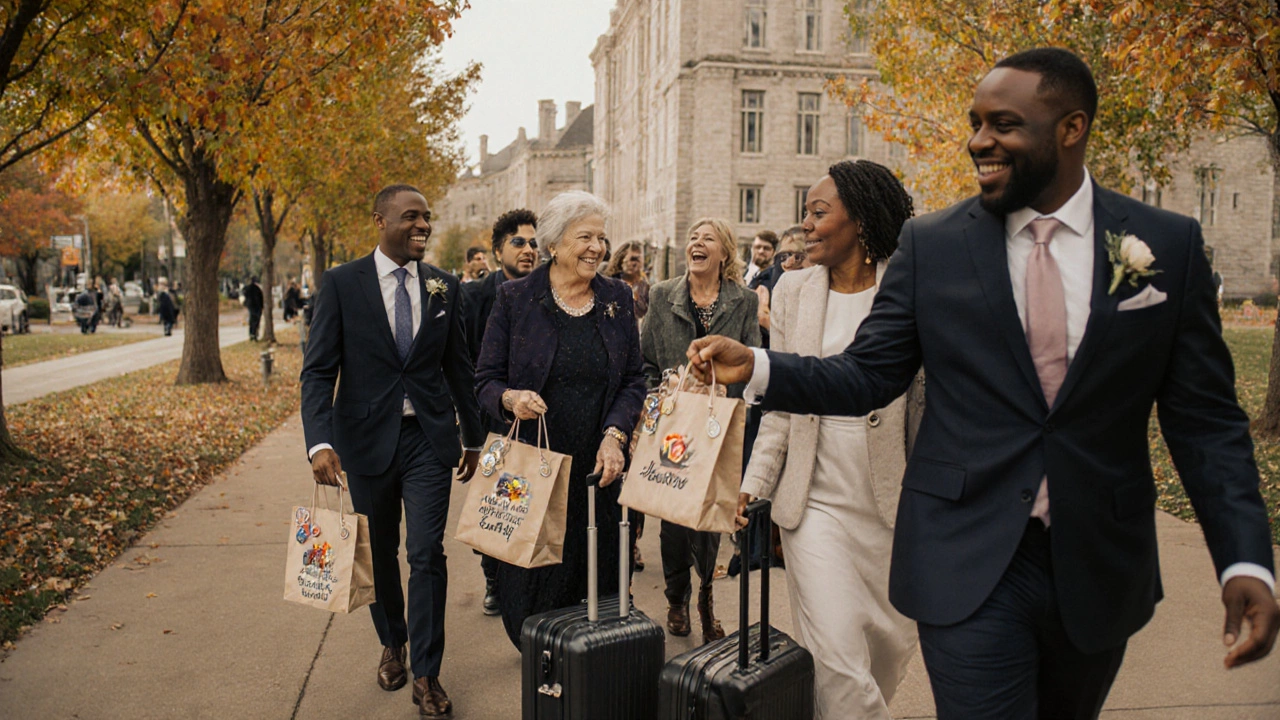Wedding Payment Contribution Calculator
Wedding Cost Estimator
Calculate typical expenses and see what the groom's parents should contribute based on modern wedding trends.
Contribution Breakdown
Please complete the form to see contribution breakdown.
Modern Wedding Note: In today's weddings, the groom's parents typically cover the rehearsal dinner, marriage license, transportation for the groom, and wedding rings. They may also help with accommodations for out-of-town guests or other items based on family discussion.
When you’re planning a wedding, money talks-even if no one wants to hear it. And one of the loudest questions? What do the groom's parents pay for? It’s not 1955 anymore. Rules have changed. Families don’t split the bill the way their parents did. But that doesn’t mean the groom’s side gets off the hook. In fact, many still step up-just in different ways.
Tradition vs. Reality
Old-school etiquette said the bride’s family paid for everything: the reception, the dress, the invitations. The groom’s family? They covered the rehearsal dinner, the officiant’s fee, and maybe the honeymoon. That’s the script. But today, less than 15% of couples follow that model exactly. A 2024 survey by The Knot found that 62% of couples pay for their own wedding, and nearly 40% of groom’s families contribute directly to costs beyond the rehearsal dinner.
So what does that mean for you? It means the groom’s parents aren’t just hosting a dinner anymore. They’re part of the financial team. And if they’re willing to help, they need to know where their money makes the most impact.
What the Groom’s Parents Typically Cover
There’s no legal contract, but here’s what most couples and families agree on in 2025:
- The rehearsal dinner-this is still the most consistent expectation. It’s not just a meal. It’s a chance to thank the wedding party, close friends, and out-of-town guests. Budgets vary: $1,500 to $8,000 depending on location, guest count, and whether alcohol is included.
- Marriage license and officiant fees-in many states, the groom’s family covers the legal side of things. That includes the license fee (usually $50-$150) and the officiant’s honorarium ($100-$500). If the officiant is a friend or family member, a thoughtful gift in place of cash is common.
- Transportation for the groom and wedding party-limos, party buses, or even rental cars for the groom, best man, and groomsmen. This is especially true if the ceremony and reception are far apart.
- Wedding rings-in many families, the groom’s side buys the rings. Not just the bride’s band, but the groom’s too. Average cost? $1,200-$5,000 per ring, depending on material and design.
- Accommodations for out-of-town guests-not always, but increasingly common. If the wedding is in a remote location or requires travel, the groom’s parents often book and pay for rooms for close relatives: grandparents, aunts, uncles, or siblings who can’t afford it themselves.
- Wedding favors or guest gifts-some families choose to handle these. A small token like custom candles, local snacks, or mini bottles of whiskey adds a personal touch. Budget: $5-$20 per guest.
What They Usually Don’t Pay For
Just because they’re helping doesn’t mean they’re on the hook for everything. Here’s what’s typically not their responsibility:
- The wedding dress and bridal accessories-this stays with the bride’s side or the couple.
- The reception venue and catering-unless they’re co-hosting, this is usually the bride’s family or the couple’s responsibility.
- Photography and videography-unless agreed otherwise, this is often split or covered by the couple.
- Wedding invitations-this is still mostly the bride’s side, but many couples now split the cost evenly. If the groom’s parents want to contribute, they might pay for extra copies for their side of the family or upgrade to premium paper.
- The honeymoon-traditionally the groom’s family, but now it’s often paid for by the couple themselves or gifted as a separate present.

When the Groom’s Parents Want to Help More
Some families want to go beyond tradition. Maybe they’re financially comfortable. Maybe they’re close to the bride’s family and want to share the load. That’s great-but it needs clear communication.
Here are realistic ways groom’s parents can step up without overstepping:
- Pay for the bar at the reception (especially if it’s open bar). This can easily add $3,000-$10,000 to the budget.
- Cover the cost of a live band or DJ. Music is one of the biggest expenses after food and venue.
- Pay for the wedding cake or dessert table. A custom cake can cost $500-$2,000.
- Provide the wedding rings as a gift. Some families buy them outright and present them on the wedding day.
- Offer to host the welcome party for out-of-town guests. This is a thoughtful alternative to just paying for hotel rooms.
But here’s the rule: never assume. Always ask the couple what they need. Don’t surprise them with a $10,000 bar tab if they’ve already budgeted for a cash bar. Don’t book a limo if they already have a friend with a nice car.
How to Talk About Money Without Awkwardness
Money conversations are hard. But avoiding them causes more stress than talking about them.
Try this script: “We’d love to help make your day special. We know you’ve been planning for a while-what’s still on your list that might be a stretch? We’d be happy to cover [rehearsal dinner, transportation, etc.].”
Or: “We’re not sure what’s expected, so we’re asking: what would mean the most to you if we helped out?”
Keep it open-ended. Let them guide you. If they say, “We’ve got it,” respect that. Offer to contribute in non-monetary ways: helping with seating charts, calling vendors, or driving Grandma to the ceremony.

What If They Can’t Afford to Pay?
Not every family has the budget. And that’s okay.
Modern weddings aren’t about who pays. They’re about who shows up. If the groom’s parents can’t chip in financially, their presence matters more than their credit card. A handwritten note, helping with setup, or even just showing up early to greet guests is just as valuable.
There’s no shame in saying, “We can’t pay for the bar, but we’ll be there with open arms and a playlist of your favorite songs.”
Who Pays for Wedding Invitations?
Let’s circle back to your original question: What do the groom's parents pay for? And yes, invitations are part of it.
Historically, the bride’s family paid for invitations because they were the ones sending them out. But today, invitations are often a joint expense. If the groom’s parents want to contribute, here’s how:
- Pay for the printing of extra invites for their side of the family.
- Upgrade the paper quality or add foil stamping for the whole set.
- Cover the cost of postage if the guest list is large.
- Pay for digital RSVP tracking or custom wedding website design.
Don’t assume they’ll pay for everything. But if they offer, it’s a sweet gesture-and a real help.
Final Rule: Communication Over Convention
The biggest mistake families make? Assuming. Assuming the bride’s side will pay for everything. Assuming the groom’s side won’t help. Assuming tradition still applies.
There’s no rulebook anymore. Only conversations.
Ask. Listen. Adjust. Celebrate.
Weddings aren’t about who wrote the check. They’re about who showed up with love.
